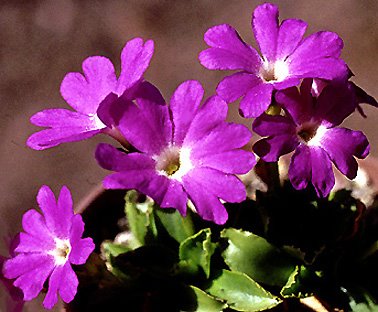Care of Flowering Houseplants
With their delicate form and ability to create a wide range of colours throughout the year, flowering houseplants always bring beauty and interest to a home, whatever their size. Even the smallest apartment benefits from a floriferous cyclamen at Christmas, a bright-eyed primula at Easter or the dazzlilng yellow, pouch-like flowers of calceolarias during the summer.

Picture showing Primrose - Primula vulgaris
Conditions
Flowering houseplants are not as tolerant as foliage types, totally disliking fluctuating temperatures, draughts and moisture variation in the compost. If abandoned to mistreatment when in flower the plants seldom fully recover, and, if just showing buds, fluctuating conditions may cause the buds to fall off. It is therefore important to take note of the temperatures, together with moisture, feeding and positioning requirements.
Orchids, in particular, require special conditions. For instance, it is important that the temperature does not fall belwo a certain level at night.

Picture: Primula x facchinii (P. minima x P. spectabilis). This is a rare hybrid, found in the mountains of South Tyrol (Italy).
Potting
Many flowering houseplants are discarded after giving their display, but some are kept from year to year. Periodically, when their roots fill the pot, plants kept throughtout the year need repotting into slightly larger containers. You should not be tempted to pot-up you plant into too large a pot, as it will then be difficult to keep the compost at the right moisture content- an important factor during winter. Some plants grow best in loam-based composts, while others need peat-based type.

Picture of Cyclamen : A very traditional plant for home use, Cyclamen are quite hearty and tolerant of cool temperatures.
Care in Winter
Winter is the most difficult time to keep flowering houseplants in good condition. This is because temperatures either widely fluctute with central heating or are just too cold, especially at night. Plants on window-sills are best removed at night to the centre of the room, and should never be left between windows and drawn curtains. It is difficult to give plants the right amount of water during winter - a period when they are not actively growing.
In summer, plants soon use up excess water in the compost, but during winter such moisture remains for a long time, causing stagnation, chills and decay, as well as facilitaing the onset of diseases. Water splashed on the foliage or flowers also encourages diseases.

Picture showing Primrose - Primula vulgaris
Conditions
Flowering houseplants are not as tolerant as foliage types, totally disliking fluctuating temperatures, draughts and moisture variation in the compost. If abandoned to mistreatment when in flower the plants seldom fully recover, and, if just showing buds, fluctuating conditions may cause the buds to fall off. It is therefore important to take note of the temperatures, together with moisture, feeding and positioning requirements.
Orchids, in particular, require special conditions. For instance, it is important that the temperature does not fall belwo a certain level at night.

Picture: Primula x facchinii (P. minima x P. spectabilis). This is a rare hybrid, found in the mountains of South Tyrol (Italy).
Potting
Many flowering houseplants are discarded after giving their display, but some are kept from year to year. Periodically, when their roots fill the pot, plants kept throughtout the year need repotting into slightly larger containers. You should not be tempted to pot-up you plant into too large a pot, as it will then be difficult to keep the compost at the right moisture content- an important factor during winter. Some plants grow best in loam-based composts, while others need peat-based type.

Picture of Cyclamen : A very traditional plant for home use, Cyclamen are quite hearty and tolerant of cool temperatures.
Care in Winter
Winter is the most difficult time to keep flowering houseplants in good condition. This is because temperatures either widely fluctute with central heating or are just too cold, especially at night. Plants on window-sills are best removed at night to the centre of the room, and should never be left between windows and drawn curtains. It is difficult to give plants the right amount of water during winter - a period when they are not actively growing.
In summer, plants soon use up excess water in the compost, but during winter such moisture remains for a long time, causing stagnation, chills and decay, as well as facilitaing the onset of diseases. Water splashed on the foliage or flowers also encourages diseases.







0 Comments:
Post a Comment
<< Home